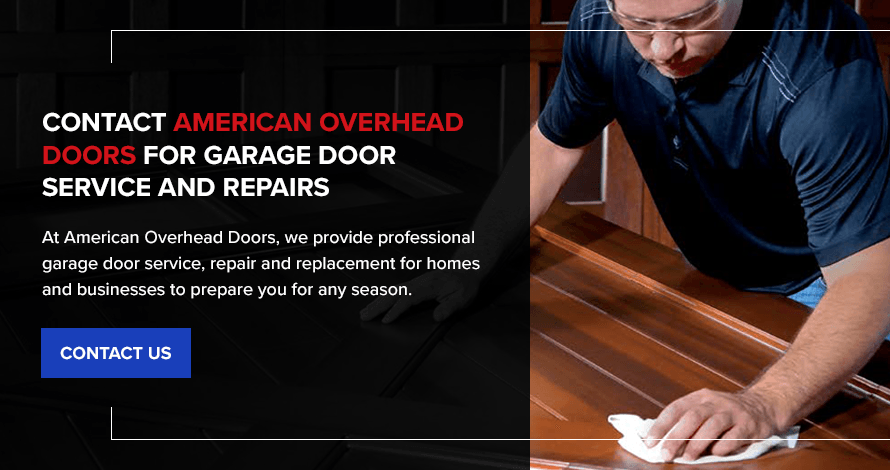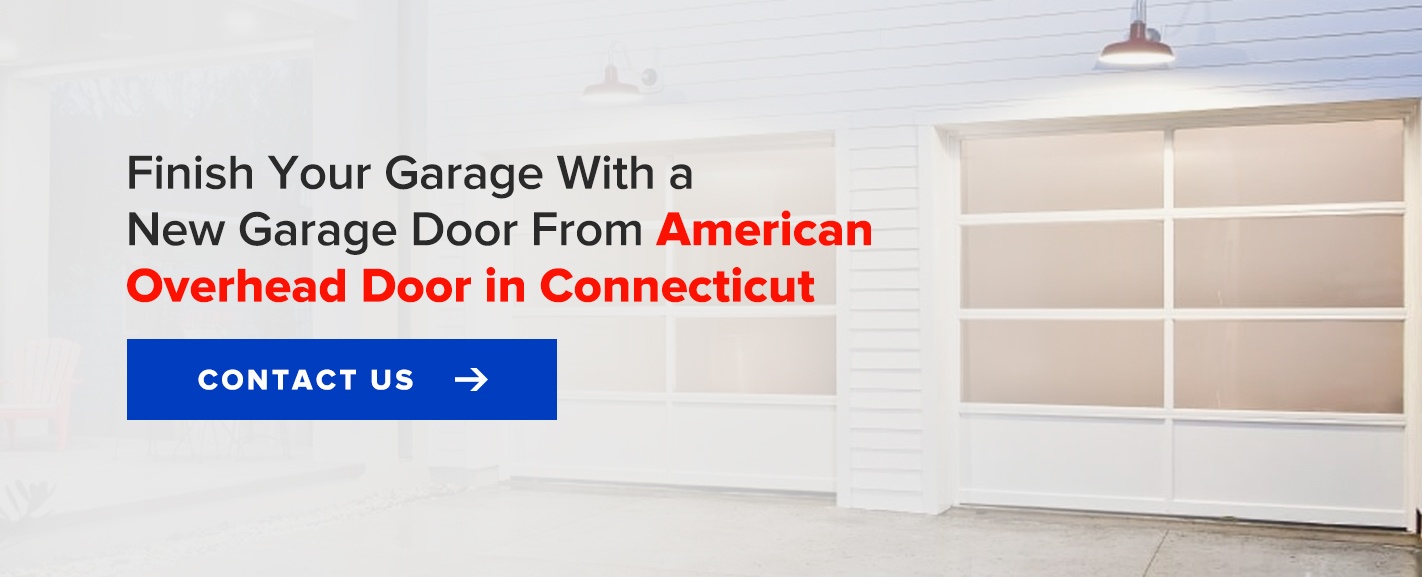How to Measure for a New Garage Door
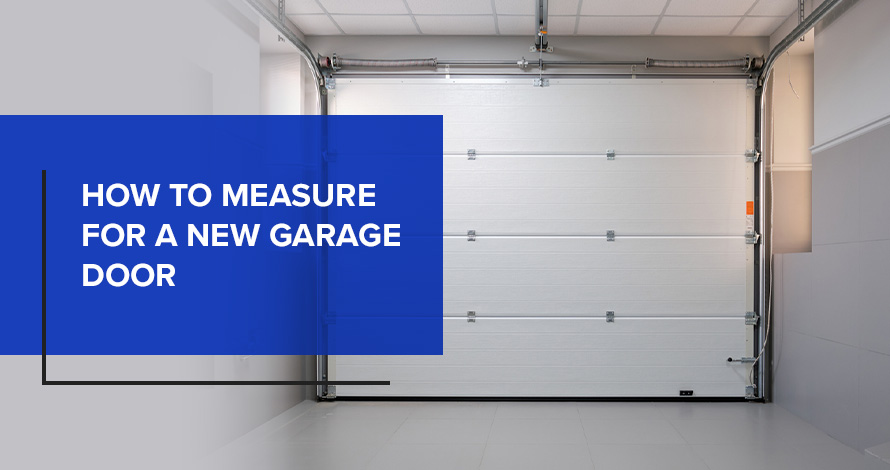
If you need to choose a new entryway, it’s vital to understand how to measure a garage door for replacement. Accurate measurements ensure your doors will fit as expected and help contractors give you a more precise estimate for your new residential or commercial garage door.
Garage Door Measuring Guide
Follow these steps when it’s time to replace or upgrade your doors.
1. Capture the Entry’s Width
Measure the widest point of your door’s opening. You should also check your door jambs to ensure they’re in good condition, squared and defect-free.
2. Measure the Opening’s Height
Find the highest point between the opening and the floor and note its distance. Inspect the floor for any damage or areas that aren’t level.
3. Get the Sideroom Measurements
Measure to the left and right of the door’s opening from the mouth to the nearest wall or obstacle. You’ll need about 4 to 5 inches on each side for mounting the vertical tracks. The center post should offer a minimum of 10 inches of width for two-door installations.
4. Find the Headroom Clearance
Record the distance from the top of the door’s opening to either the nearest obstruction or the ceiling. For most doors, you’ll want at least 15 inches.
5. Capture the Backroom Clearance
Measure the distance between the door’s opening and the back wall or nearest obstacle, such as a lighting fixture. For a sectional-style residential door, you’ll need a minimum of the door’s height plus 18 inches for a manually operated door. When using an overhead opener instead, add 50 inches to the door’s height to find the minimum clearance requirement.
Special Considerations for Commercial Doors
Clearance requirements for commercial models vary significantly based on the door’s style and height. Generally speaking, you’ll need:
- Backroom width equal to headroom space for coiling doors.
- Backroom equal to the door’s height plus 23 inches for a 2-inch track or 25 inches for a 3-inch track — and more if you install an overhead operator.
- Clearance of 4 to 6 inches per side for a manually operated door.
- Clearance of 5.25 to 9.5 inches per side for doors operated by a chain hoist.
- Clearance of 14 to 18 inches on at least one side for motor-operated models.
Request an Estimate From American Overhead Doors, Inc.
American Overhead Doors, Inc. is a family-owned company with over 30 years of industry experience, five-star reviews and customer praise. Our well-qualified team can help you with professional garage door replacement, residential door repair services and commercial repairs.
Take the next step and request a custom estimate today, or call us at 860-347-1507 for personal assistance.
Dangers of DIY Garage Door Repairs
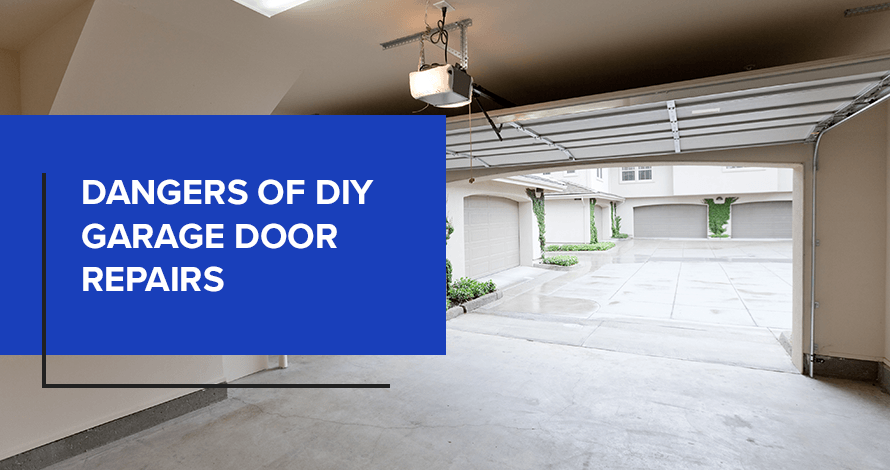
Many homeowners or business owners use their garage doors several times per day, resulting in a lot of wear and tear. Eventually, your garage door will need some repairs. When you notice your garage door is working incorrectly, you may try to do the repairs yourself. This can be costly, difficult and even dangerous. Your best course of action is to hire a professional to get the job done, keeping you and your loved ones safe from garage door repair dangers.
Garage Door DIY Dangers
If you’re wondering if you should fix your garage door yourself, we recommend thinking about the possibilities first. Let’s face it — a broken garage door is a huge inconvenience. You may want to grab your toolbox and start tinkering with your garage door to get it up and running, but this could have poor results. Consider the dangers of repairing your garage door yourself to help make a safe and affordable decision:
1. DIY Repairs Can Get Costly
One of the main reasons people try to repair their garage doors themselves is to save some money. Many assume getting a professional to repair their garage door will be costly. You may feel like it’s simply not in the budget, but think again.
When you repair your garage door yourself, you run the risk of making things worse than they already are. Garage doors are complex pieces of equipment containing motors, electronics, hinges, springs, cables and many other components. A simple mistake can lead to more damage, repairs and money spent trying to solve the problem. Over time, this could cost much more money than the cost of hiring a professional.
2. Repairing Your Garage Door Yourself Is Time-Consuming
Time is one of your most valuable resources, and you’re always spending it. Chores and maintenance are a normal part of life for business owners and homeowners, but sometimes, it’s better to leave certain tasks to the people who do them for a living.
Your garage door repair may seem simple at first, but it could easily turn into a whole afternoon of work. An afternoon repair could turn into a whole-day project, then a weekend project. Soon, you may find yourself spending several weekends trying to fix an issue that a professional could solve in a couple of hours. Take control of your schedule and let the garage door professionals do the fixing.
3. You Could Damage Your Belongings
If you’re one of the countless homeowners or business owners who use their garage for storage, you should think twice before trying to do your own repairs. You may store valuable items in your garage, including the vehicle you use for daily transportation. A mistake in your repair work puts these items at risk.
Improper repairs and installation could result in your garage door falling down, crashing into your car or valuable items. Although this event would be the worst-case scenario, it’s a possibility you should be aware of. You could be out of a garage door and a car, causing you to spend far more money than you planned.
4. Falling From a Ladder Is a Serious Danger
If you try to repair your garage door yourself, you’re going to need a ladder. Whether you need a small boost or you have to climb several feet high, using a ladder could be dangerous. Ladder use puts you at risk of falling and sustaining serious injuries and even death.
Each year, ladders account for 500,000 injuries and 300 deaths. While you can use safe ladder practices to reduce the risk of an unfortunate situation, you may be better off staying on the ground and letting a trained professional go up to repair your garage door. A simple misstep can have disastrous results. You can remove this possibility by hiring a professional instead.
5. Garage Door Springs Are Complicated and Dangerous to Repair
Garage door torsion springs allow your garage door to open and close with ease. Without these springs, garage doors would feel heavier, and your garage door opener would have to work harder to function. These springs have a limited life span, and they’ll eventually need replacement if you want to keep using your garage door.
Is it dangerous to replace garage door springs? Ask any garage door professional, and they’ll tell you to always leave spring work to people who know what they’re doing. These springs are under a lot of tension, and a simple mistake can unleash this potential energy on you. You could suffer serious injuries or even death. If you think something is wrong with your garage door springs, keep a safe distance and call a professional right away.
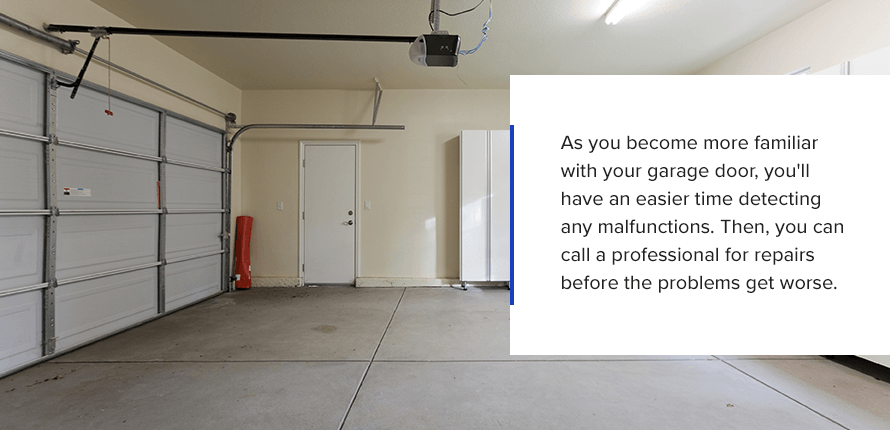
Safe Garage Door Repair Solutions
Though many fixes should be left the pros, you can still troubleshoot some garage door repair solutions. As a homeowner or business owner, you can improve your garage door’s functioning by doing the following:
- Test your garage door’s safety features to make sure they’re working.
- Keep the photo eye sensors at the base of your garage door aligned and cleaned.
- Lubricate the moving components of your garage door on a regular basis.
- Inspect your garage door and listen for unusual sounds during operation.
These activities can go a long way in preserving the life of your garage door. As you become more familiar with your garage door, you’ll have an easier time detecting any malfunctions. Then, you can call a professional for repairs before the problems get worse.
Should I Hire a Garage Door Repair Professional?
When you hire a garage door repair professional, you can enjoy the following benefits:
- Faster repairs: Professionals know what they’re doing, reducing the length of time needed to make the repairs.
- Lower costs: When you hire a professional, you’ll get the repair you need the first time and avoid mistakes that could lead to extra costs.
- Increased security: Keep your car and possessions safe with a functioning garage door. You’ll enjoy peace of mind knowing your garage door will keep you safe and protected.
- Safety: It’s dangerous to perform garage door repairs yourself. Let the trained professionals handle your repairs so you can stay safe and healthy.
Contact American Overhead Doors, Inc. for Professional Garage Door Repair Services
Invest in your safety and well-being by letting the professionals at American Overhead Doors handle your garage door repair needs. Whether you need residential garage door work or a commercial garage door fix, our repair and maintenance services will get the job done. We’ve been in business since 1987, so you can trust our expertise and years of experience for your garage door needs.
Contact us online today to learn more about how we can help save you time and money by repairing your garage door.
My Garage Door Is Frozen Shut
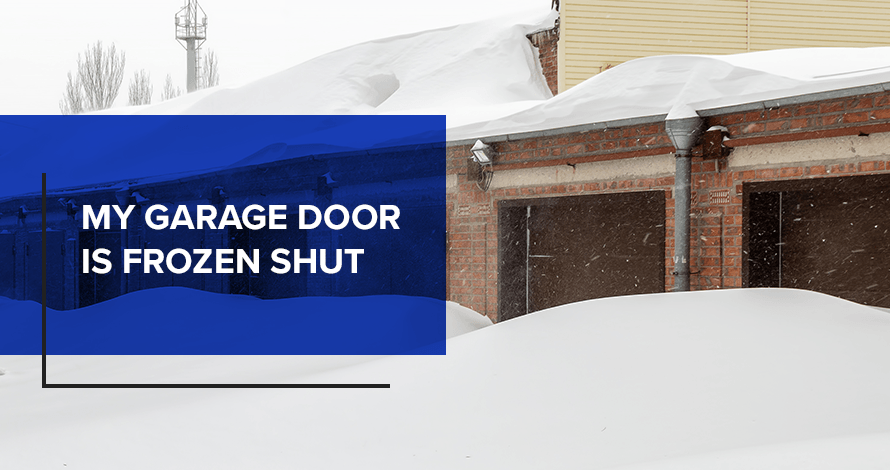
You’re heading out on a cold morning, bundled up and prepared to go. But when you try to leave, you realize your garage door is frozen shut. Or perhaps you arrive at your business, ready to work. But when you try to open the garage, the door doesn’t move. If your garage door gets stuck when it’s cold or you want to prevent a frozen garage door, you need this guide.
Your garage door is a main entry point to your home or business, so you need it to function year-round. Learn more about how to get a frozen door open and prevent this problem in the future.
Schedule a Service Appointment
What to Do If My Garage Door Is Frozen Shut
If you try to open your garage door but it won’t budge, don’t try to push the automatic opener button again. Doing so risks damaging the door or the system, creating a dangerous situation.
The first thing you should do if it’s cold and your garage door won’t operate is check that your garage door is frozen to the ground. You don’t want to go through all the steps of unsticking your door if there’s really an issue with the opener. If you see ice built up under the weather seal, continue with these steps:
- Remove and chip away ice: Grab an ice scraper and move to the outside of your garage. Chip the ice away, being careful not to hit the weatherstripping seal along the bottom. Remove as much as you can and sweep it away from the door.
- Loosen your door away from the frozen seal: With the excess ice removed between the door and the ground, try to lift the door manually. Don’t force the door open if it doesn’t move easily. Instead, go back and try to chip away more ice or follow the next step.
- Apply heat to the frozen area: Set a blow-dryer or heat gun to a low temperature and direct it at the remaining areas of ice buildup. If you have a heater in your garage, you can turn that on near the door, keeping the heat low, to help melt the ice. You can attempt to chip away the remaining ice once it’s somewhat melted.
During these steps, try not to use too much force. Disengage the automatic opener and try to lift the door manually. That will avoid putting strain on the opener system. You could also consider using hot water to help melt the ice, but note that if temperatures are extremely low and you use a lot of water, it could create more ice later on.
If you have ice melt or rock salt, you could throw it down for a solution that will take longer but won’t involve as much effort on your part. Once the ice melts, you need to clean away the salt to prevent corroding the material at the bottom of your garage door.
As for how to close a frozen garage door, you may need to check the panels and other components to make sure nothing is frozen there. Use a hair dryer or heat gun on a low setting to melt the ice away from these areas and close your garage door. You could also contact American Overhead Doors for services to avoid causing any damage to your garage door or opener system.
How to Prevent My Garage Door From Freezing Shut
Preventing a frozen garage door can save you the hassle and time required to unstick it. If you know cold weather and freezing conditions are on the way, take some steps to help maintain your garage’s functionality, especially when your garage door freezes to the ground often:
1. Clear Water, Ice and Snow Early
Whether you just unstuck your garage door or you’re checking it before cold weather, clear any ice, snow and water from the floor. The sooner you catch these concerns, the easier it can be to maintain your door. If the garage door can operate, keep it open as you scrape, sweep or shovel the ice and snow away.
If the temperature hasn’t dropped yet but the garage floor is wet, open the door and dry the area. Use dry towels and mops to pick up the water or a wet vacuum if there are any puddles.
Clearing ice and snow away also involves keeping your driveway clear. Your vehicle or anyone walking into the garage can track in snow, and snow close to the garage door can end up underneath it. That could eventually create a garage door that’s frozen shut.
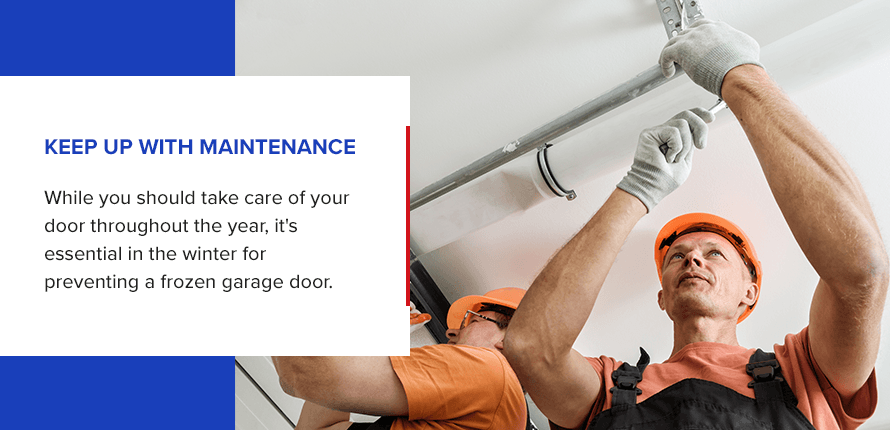
2. Keep up With Maintenance
Preventative garage door maintenance is essential to maintain the door itself and the opener system. While you should take care of your door throughout the year, it’s essential in the winter for preventing a frozen garage door. Keep up with maintenance with these steps:
- Lubricate the seal at the bottom of the door.
- Lubricate other components, like rollers, springs and hinges.
- Look for moisture buildup.
- Check for damaged or worn components.
If you notice any problems with the garage door opener components, contact a professional for repairs and maintenance assistance. An opener is a delicate system with parts under great tension, and trying to maintain those yourself could create a dangerous situation.
3. Open and Close the Door Periodically
Operating your garage door can help it from freezing. As the garage door moves, thin layers of ice that started to build up can more easily break away. That can make it simpler to clear away ice later, and it could prevent your garage door from freezing shut.
If you’re able, manually opening and closing the door is ideal. You don’t want to risk damaging the opener system by automatically opening it if the door is stuck. With your door in the closed position, pull the release cord. That disengages the opener and lets you lift and close the garage door manually. When you’re done, pull the cord toward the door and reengage the opener.
4. Layer Sand or Salt Where the Door Touches the Ground
Throw salt down where the garage door touches the ground to prevent ice from forming in the first place. A light sprinkling of sand or rock salt is sufficient, so avoid spreading too much. That could impact the weatherstripping at the bottom of the door.
Once the weather warms up, make sure you sweep away leftover salt or sand and clean the components at the bottom edge of the garage door. This helps to avoid causing damage while trying to prevent your garage door from freezing to the ground.
5. Avoid Warming Your Car in the Garage
Running your car in a closed garage is dangerous because it releases carbon monoxide. Even with the door open to let the hazardous gas out, your car can melt ice and snow on the garage floor, creating puddles of water under the door. Unless your garage is heated, those puddles will refreeze once you leave and shut the door.
6. Install a Garage Heater
A garage heater can keep your garage warm and comfortable, making it more suitable to store your items year-round. A heated garage can also prevent your door from freezing as the floor is warmer and prevents ice from building up. It’ll also keep the door warmer to prevent sticking throughout the panels. Buy an insulated garage door to help your garage heater stay efficient.
Contact American Overhead Doors for Garage Door Services
If your garage door sticks in cold weather, seek help from the experts at American Overhead Doors. We’ve been proudly offering our services to all of Connecticut for decades. Those years of experience and our expert team of trained technicians give you the best residential and commercial garage door services in the state. Whether your garage door gets stuck in winter or you need services other times of year, call on us to help.
Contact us today to schedule garage door services, whether you need replacements, repairs or help with a frozen garage door.
Preparing Your Garage Door for Winter
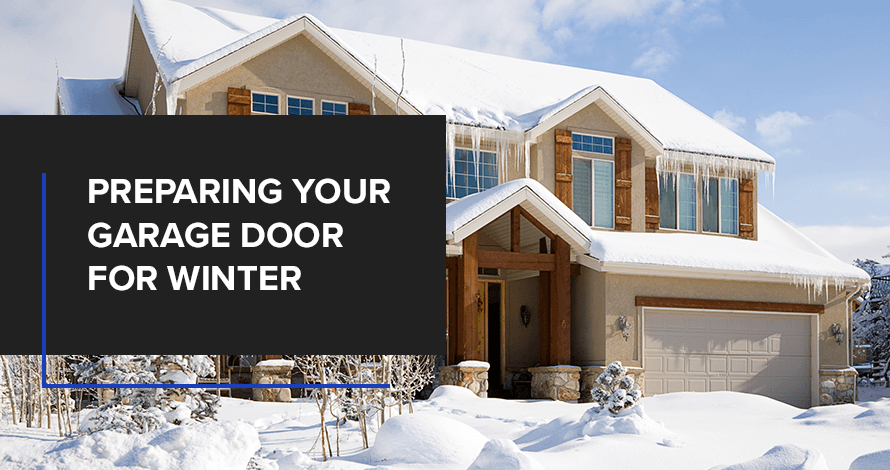
Your garage door is likely the largest functional appliance of your home or business. It withstands heavy use as you might open and close it thousands of times each year and multiple times a day. It’s exposed to the elements of each season, sustaining a great deal of wear and tear. The cold winter weather in a state like Connecticut can be unforgiving, so it’s important to prepare your garage for winter.
There are several precautions you can take before temperatures start to dip. Investing in these precautions can help prevent emergencies and reduce repair costs long term. Many precautions are quick and inexpensive, but have a significant impact. Learn how to seal your garage door for winter and discover other steps you can take below.
Schedule a Maintenance Appointment
How Does Cold Weather Affect Garage Doors?
Extreme cold and exposure to snow, sleet and ice can have an adverse effect on any appliance or piece of machinery. Your garage door is not immune to these impacts. It has several elements that are sensitive to the effects of winter. Though garage doors can be many different materials, none can withstand winter without any preparation. Here are some common garage door issues in cold weather:
- Shrinking metal: Particles move slower and take up less space when chilled. As a result, the cold causes metal to contract. Pieces of hardware like springs and screws will shrink. When this happens, your door might not be able to open and close. Springs can snap, and the metal track can warp. Proper weatherstripping, insulation and lubricating oil can minimize the effects of contracting metal.
- Allowing cold in: A lack of proper insulation allows the cold to seep in, which can affect the temperature of your living or working space. This can drive up your energy bills and make your indoor space less comfortable. Insulation and weatherstripping also help solve this problem.
- Absorbing water: As snow and sleet fall, parts of your garage door might absorb water, causing swelling. The swelling might prohibit closing. If the absorbed water freezes, the door could freeze shut. Doors with wooden panels are the most susceptible to this issue, and protective treatments can prevent this from happening.
- Fogging sensors: The safety sensor on your garage door keeps it from closing if it perceives an obstacle in the way. Winter weather can cause the sensors to fog over, mimicking an obstacle. Piled up snow or ice near the bottom of the door can have the same effect.
- Getting stuck: Any of the above issues can cause your garage door to get “stuck” and be unable to open or close. Precautionary measures protect your garage and prevent the door from sticking.
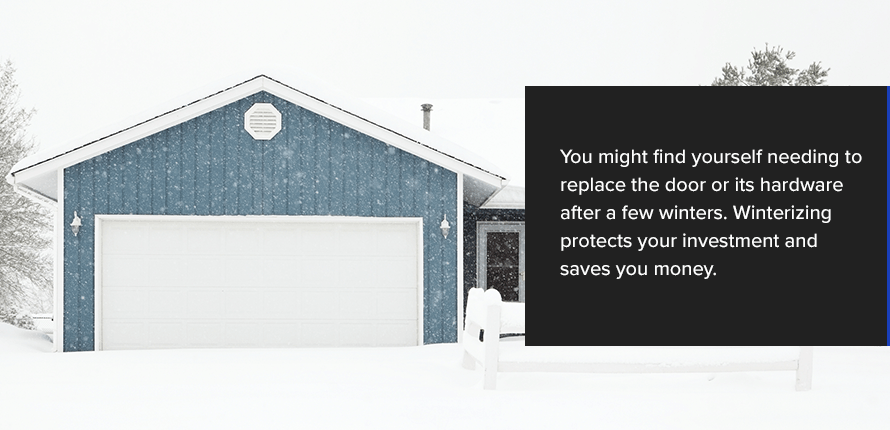
Why Winterize a Garage Door?
Preparing your garage for winter is vital to avoid ending up in an emergency situation with a door that refuses to move. A door stuck closed can be a serious dilemma — if your vehicle is trapped inside, you’ll have a hard time getting anywhere. If your vehicle is trapped outside, there’ll be nothing to protect it from the elements. And if your door is stuck open, everything in your garage will be exposed and you’ll have a tough time regulating the temperature. Even if your door functions without getting stuck, poor insulation can cause burst pipes and higher heating bills.
Winter weather will affect other elements of your garage in addition to the door. The cold can cause your pipes to freeze. The snow, ice and salt on your vehicle can erode your concrete floors. If shared walls are not well insulated, your heater will have to work harder, driving up your utility bills. An unprotected floor can also worsen insulation problems by creating cracks and gaps.
In addition to momentary inconvenience, the effects of winter can shorten the life span of your garage door. You might find yourself needing to replace the door or its hardware after a few winters. Winterizing protects your investment and saves you money.
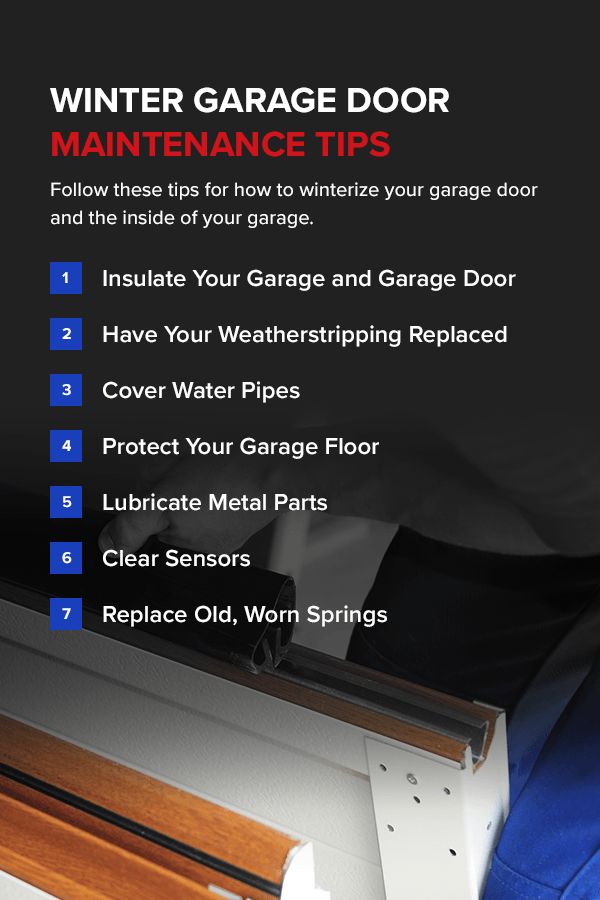
Winter Garage Door Maintenance Tips
As temperatures drop and the first snowfall looms, take some time to prepare your garage. Some tasks you can do on your own, while others may require professional service. You’ll find even the simplest preventive maintenance tasks can make a huge difference. Follow these tips for how to winterize your garage door and the inside of your garage.
1. Insulate Your Garage and Garage Door
It’s helpful to keep your garage warm during winter by installing proper insulation. You’ll find this has several benefits, including:
- It protects the internal hardware of your garage door.
- It protects the objects stored in your garage.
- It can lower your energy bills and improve the efficiency of your heating.
- It makes your garage a more livable, usable space during winter.
Many garages share at least one wall with a home or building, so proper insulation has a significant impact on indoor temperature regulation. At the least, you’ll want to improve the insulation of the shared wall to create a temperature barrier. If you’re thinking about upgrading or replacing your garage door, consider a well-insulated material. For instance, a four-layer garage door is ideal for extreme weather conditions.
Improved insulation is always beneficial, whether you only use your garage for storage or it has multiple purposes. If your home’s garage stays at a comfortable temperature, you can use it as a studio, home gym or children’s play area. In a business setting, you can make better use of a well-insulated garage. You can store valuable items or perform tasks in the garage.
2. Have Your Weatherstripping Replaced
You may notice tiny gaps along the edges of your garage door. It’s important to close these gaps with proper weatherstripping. Sealing door gaps in the winter will keep cold air, snow and ice from seeping into your garage and causing damage. Cracks along your garage door can also lead to pest issues, so these spots always need resealing. Professionals use polyvinyl chloride (PVC), vinyl or rubber to close off the gaps. They’ll also clear away any dirt or grime from the seal. Follow these garage door weather seal tips:
- Look for light: To check for cracks along the edge of the door, stand outside after dark and look for spots where light shines through. If you can see light, there’s a big enough space for temperature or moisture leaks.
- Use a bottom or threshold seal: If your garage floor has cracks or crevices where it meets the door, this can result in gaps. To fill those gaps, attach a strip of rubber or vinyl along the bottom edge of your garage door. You could also attach a threshold seal to the floor to serve the same purpose, but note that a threshold seal might make it harder to sweep or hose debris off your garage floor.
- Replace weatherstripping: Along the sides of the door, you’ll need to replace any worn weatherstripping, which attaches to the edges with nails or screws.
- Weatherstrip between panels: Gaps can also form between individual door panels. When that happens, apply weatherstripping along the borders of the panels.
3. Cover Water Pipes
When water pipes freeze, the built up pressure of running water can cause them to burst. A burst pipe can lead to dangerous and damaging flooding. Water pipes running through exterior walls, attics or garages are the most vulnerable. It’s important to insulate these pipes before temperatures fall too low.
If you choose to install insulation on your own, make sure to wrap all pipes in unheated spaces, for both cold and hot water. Use a pipe sleeve and wrap it tightly, leaving no room for sweating. You can also take the following precautions to avoid frozen or burst pipes:
- Keep a faucet dripping to avoid pressure buildup.
- Keep your thermostat on and heat running, even if you’re away for an extended period.
- Improve the insulation of your unheated spaces, including the garage.
4. Protect Your Garage Floor
Your garage floor withstands a lot in the winter, including vehicle and foot traffic, dirt, mud, automotive fluid, ice, rainwater, ground salt and sand. An unfinished concrete surface is more porous than you might realize. Like metal, concrete expands and contracts with the temperature. With exposure to moisture, it’ll freeze and thaw. This results in cracking, crumbling or flaking.
The sand and salt that are meant to improve traction on the road are abrasive to your floor. To avoid these issues, you can take a few precautions. Choose from any of the following methods, noting their pros and cons:
- Applying protective coatings: A protective coating of epoxy or polyaspartic will protect your floor and improve its appearance. Keep in mind that you have to apply epoxy in mild temperatures. If you wait too long into the season, epoxy is no longer an option.
- Applying clear sealants: Sealants offer a clear film to protect against damage. If the floor underneath has uneven coloration or surface damage, those issues will still be visible.
- Laying down snow mats: A cost-effective way to protect your garage floor is to lay down snow mats. A rubber or vinyl snow mat will provide a protective barrier between your concrete floor and the snow, ice and salt. They’re an impermanent solution as they can come loose, tear or fray over time.
- Installing interlocking tiles: Another inexpensive option is to install rubber or PVC interlocking tiles. If you use tiles, create a drainage system for the water that collects on the surface.
In general, try to keep your garage floors as dry as possible. If you can, clean snow off your vehicle in the driveway before pulling into the garage. Use a shovel and a squeegee to remove snow and ice from the floor. Regular cleaning throughout the winter will reduce the burden on your floors.
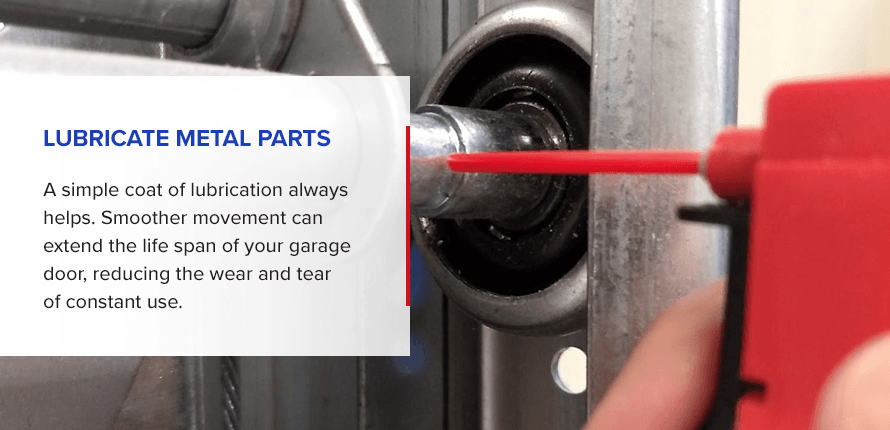
5. Lubricate Metal Parts
Spray lubricant on all your garage door’s moving metal parts, like springs, bearings and hinges. This is an easy do-it-yourself project that can make a huge difference. You can use standard engine oil, but avoid thick grease. If it’s too thick, it’ll make tracks stick and collect debris. When you apply the spray, work around plastic pieces. Afterward, wipe away excess lubricant to keep it from dripping on the floor.
A simple coat of lubrication always helps. Smoother movement can extend the life span of your garage door, reducing the wear and tear of constant use. While you should apply lubricant before winter, you can also apply it any time of year. To see if your garage door needs lubrication, watch as it opens or closes. See if it sticks or struggles at any point. If it does, apply lubricant.
6. Clear Sensors
As mentioned above, winter fog can inhibit your door’s safety sensors. These safety sensors are a vital element of your garage door. Garage doors are heavy and can cause severe injury if someone gets caught underneath. Photo eye sensors keep this from happening, stopping the door when there’s an obstacle.
If your door refuses to open or close, a blocked sensor may be the cause. Thankfully, this is easy to fix. Wipe the photo eye sensors so they can operate as they should. You’ll also want to clear away leaves, dirt, dust and snow from the lenses. Keep the area around the base of the door unobstructed, and shovel away snow and dirt.
7. Replace Old, Worn Springs
The metal hardware on your door needs to be strong when winter comes around. Worn metal components can compromise your door’s ability to function. Before winter, you might want to have a professional replace your springs. Grinding or squeaking sounds or stuttered movement might indicate an issue with your springs. First, carefully apply lubricant. If the issue persists, contact a professional service to replace the broken springs.
What to Do if Your Garage Door Is Not Working
Whether or not you’ve taken necessary precautions, emergencies can happen. In some situations, you need an immediate fix and waiting several days is not an option. For example, if your door is unable to close, everything in your garage is vulnerable to the elements. In a scenario like this, contact a 24/7 emergency repair service. An on-call technician will arrive to address the issue so you can continue your regular activities.
Contact American Overhead Doors for Garage Door Service and Repairs
When preparing your home or business for the harsh Connecticut winter, it’s important to remember the garage. Your garage has to withstand heavy use in all climates, rain or shine. At American Overhead Doors, we provide professional garage door service, repair and replacement for homes and businesses to prepare you for any season. Whether you’re looking for preventive maintenance, part replacement or emergency response, we can help. For all your garage door needs, contact American Overhead Doors today.
Tips for Garage Door Safety Month 2020
It’s June, which means it’s Garage Door Safety Month! Here’s a friendly reminder to ensure that you and your family maintain a safe home environment. Your garage door may not seem like the biggest threat, but many individuals are hurt by garage door malfunctions each year. Fortunately, you can help prevent these accidents. Start by taking a look at these garage door safety tips.
1. Check Door Balance
Your garage door should move up and down with ease when it’s balanced. If you neglect its maintenance, however, it can become unbalanced. You’ll notice this problem if your garage door seems unevenly weighted. You can test your theory and determine a solution with a few tricks. It’s smart to conduct this check every few months to stay safe.
Turn off your garage door’s opener. Then, slide it up and down the tracks a few times to see if it glides smoothly. Let go at a certain point to see if the door stays put. If it moves, you’ll know there’s a balance problem. You may need to replace your garage door’s springs — it’s best to contact a professional for this project.
2. Look for Wear
You should check your garage door for wear and tear. All garage doors endure damage over time, especially when it comes to severe weather. If yours has cracks or dents, it likely doesn’t function as it should. Plus, any moisture buildup can lead to mildew and rot. It’s more common for wooden doors to take on water-related decay, but you should make time to check for these issues no matter your door’s material.
You can use a flashlight to illuminate your garage door’s cracks and crevices. If you notice any prominent damage that may affect your door’s performance, you should have an expert take a look.
3. Test Door Sensors
Your automatic garage door can prevent injuries, but only when it works correctly. A garage door that comes with sensors and functions properly can sense when there’s an object around or underneath it. It won’t close unless the item moves. However, if the sensors are damaged, missing or misaligned, your garage door could shut abruptly even if there’s an obstruction. Your sensors can help you avoid such risks.
Look at your garage door’s sensors to see if there’s an LED light. Do you notice any blinking? If you do, it’s time to readjust them. You can use a screwdriver to secure the bracket around the sensor. Once it’s secured, the sensor should be ready to work correctly.
4. Consider a Tuneup
How do you keep your garage door safe and operating as intended? An annual garage door tuneup can answer this question. A professional can inspect your door to ensure that it works properly. They’ll check hardware and cables to make sure every component is secure. An expert can also replace different parts that could’ve worn down over time. Opting for regular tuneups is one of the best steps for keeping a garage and garage door system safe.
Contact a Garage Door Specialist at American Overhead Doors, Inc.
If you want to ensure that your garage door works reliably, contact us at American Overhead Doors, Inc. today. Our garage door specialists can conduct a check and provide specific recommendations that enhance your safety. Whether you need a spring replacement or a new garage door entirely, we’re here to provide reliable service for anyone in the state of Connecticut.
DIY Garage Organization Tips and Tricks
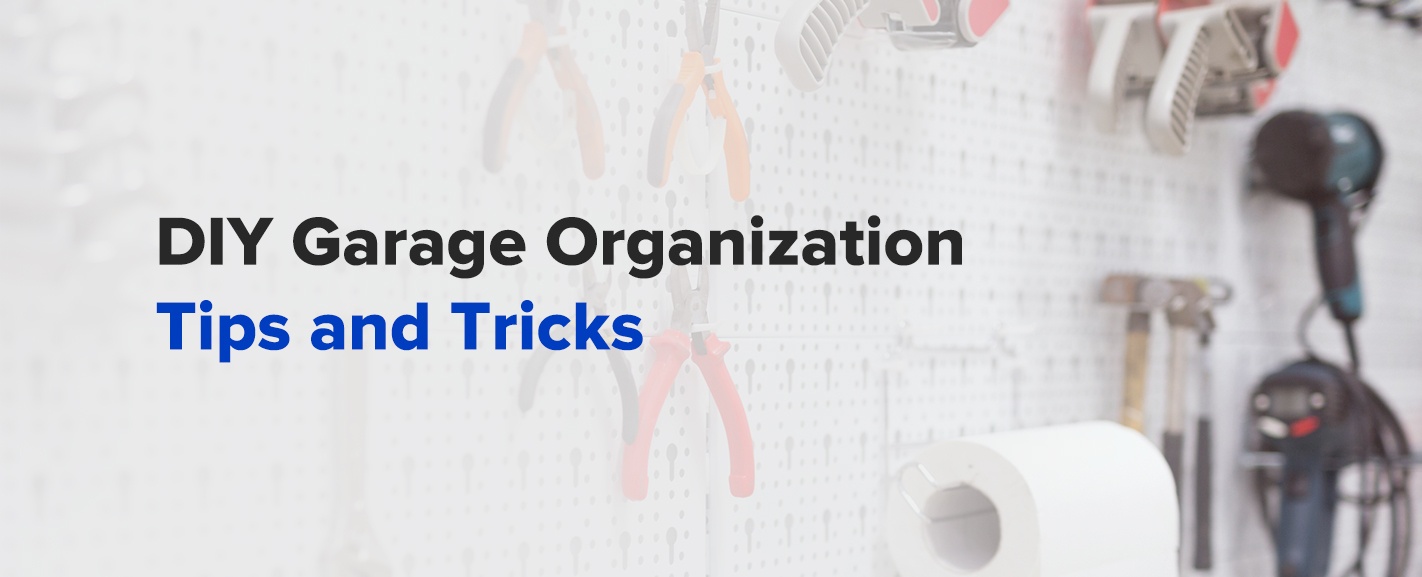
Clutter can pile up in the garage if you’re not careful. Go through the treasures in your possession and get some new garage storage. You can organize this area of the home using the free space on your floor, walls and ceilings.
Do you want to use your garage to protect your car from harsh weather, but accumulated junk forces you to park in the street? Use this guide to discover some brilliant garage organization tips.
How to Start Organizing Your Garage
To help you organize your garage, make a checklist. Here are some garage organization plans to consider. Make sure you have these items on hand before you start your cleaning project:
- Vacuum, mop or broom
- Trash bags
- Baskets or cardboard boxes
1. Schedule Time
Be realistic about how long this project is going to take you. Organizing the garage takes the average person about a day. The project may take longer, depending on the weather or family obligations.
Take out your calendar and find a day you’re available to start organizing your garage. Look at the next couple of steps and figure out how long it’ll take you to complete each task. Knock out the cleaning project on a sunny spring day, or spread it out over a couple of weeks.
2. Sort Your Clutter Into Piles
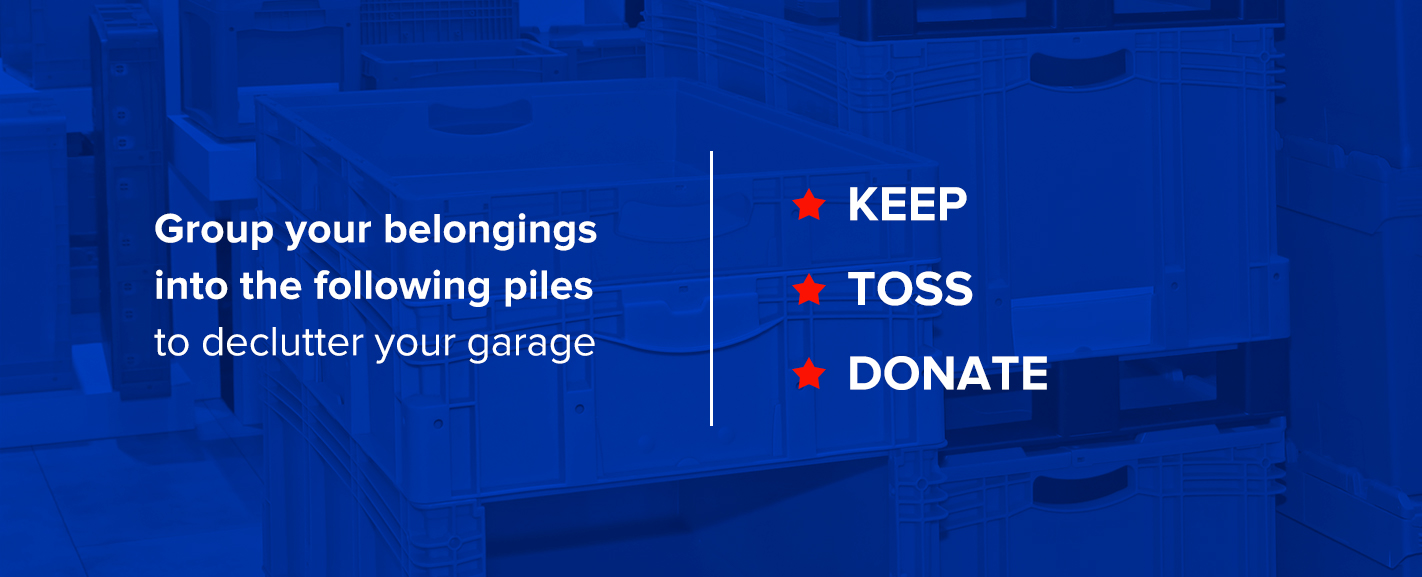
Clear all your possessions out of the garage and put them in a visible area. Grouping your belongings into the following piles is how to declutter your garage.
- Keep: Store these items in temporary boxes until you know where you want to make their forever home.
- Toss: Throw out these items in trash bags for garbage day.
- Donate: If your items are in good condition, but you have no use for them, consider donating them to a local charity.
As you examine each item, think about how often you use them. Sort your things in categories, like sporting equipment or tools. You should donate or get rid of items that don’t fit in a group and don’t serve a purpose in your home.
If you’re not sure about keeping or tossing an item, put it to the side and work on the rest of the pile. After a couple of hours, go through the heap again and decide what to do with those miscellaneous items.
3. Organize Your Garage Into Zones
Split your garage into different categories and put things in their respective places. Each of the items in your garage needs a special place to call home. That way, after you use something, you can put it back where it belongs.
How to arrange your garage depends on what works for you and your family. You could use any of the following categories to decide where to put your possessions:
- Car supplies
- Recyclables
- Sports equipment
- Tools
- Children’s toys
The items you use the most should be in accessible places. Put the recyclables by the garage door and bring them outside. Keep things that could be harmful to your children or pets in high places they can’t reach.
Organizing your garage in zones also helps your family find their belongings. You know where you put everything, but other members of your household should be able to find them even when you’re not around. Creating space for each item in your garage will make it easier to find and put back their possessions.
4. Brainstorm Storage Options
You could use different types of DIY garage storage to put away your stuff. Use storage space that’s easy for you to access when you need the items in your garage. Here are some ideas to get organized.
- Plastic storage boxes: Instead of flimsy cardboard boxes, uses plastic boxes for permanent storage. Waterproof plastic containers are easy to transport and protect your belongings better.
- Labels: If you use plastic bins or drawers, group all similar items together in the same storage unit. Have a permanent marker and white masking tape ready for labeling your possessions.
- Shelves: Install shelves to keep items off the floor. Shelves also help you see and access your possessions.
- Built-in cabinets: Take advantage of wall space with cupboards. You could put items you don’t use every day in these storage units. Lock tools or harsh chemicals out of reach, away from pets and small children in your household.
5. Keep the Garage Clean
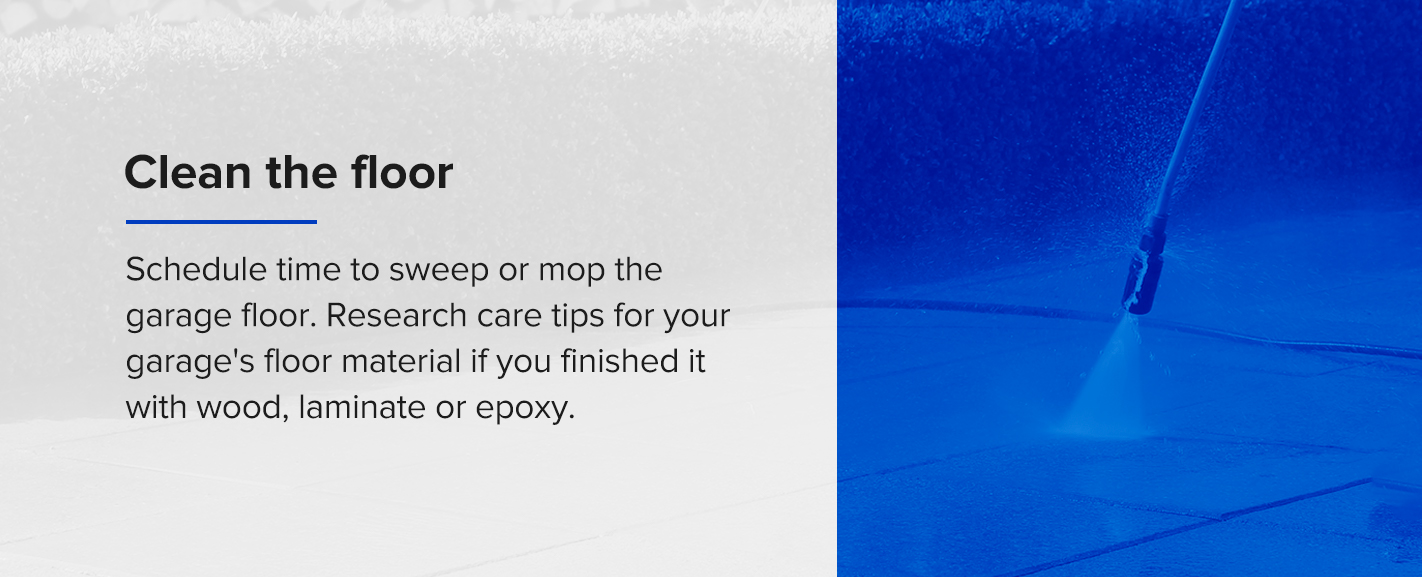
After you’ve done a sweep of your garage, you should keep it clean. You’ll be able to maintain your garage better when you do a quick clean once a week. Now that you’ve removed the excess clutter, it’ll be easier to maintain.
Here is how to keep your garage clean.
- Put your car in it: When you park your vehicle in the garage, you’ll have less space for clutter. Make a habit of parking in your garage, so you don’t throw other items in that space.
- Clean the floor: Schedule time to sweep or mop the garage floor. If you have an unfinished concrete garage floor, use a mop to clean the floor. Research care tips for your garage’s floor material if you finished it with wood, laminate or epoxy.
- Put items away after you use them: Now that you have a designated space for all the items in your garage, you have to put them back where they belong after you use them. There’s no excuse for leaving things on the floor or in front of the entry door.
Space-Saving Garage Storage Ideas
As you figure out where to store the items in your garage, put your car in the space. Measure the area around your vehicle to find out how much free space there is for storage. Here are some DIY garage storage ideas.
1. Use Plastic Bins and Containers
Plastic bins help you store your items in different categories. Keep your stuff out of the way with these clever garage storage ideas.
- Opaque storage bins for privacy: Colorful plastic storage bins help you hide items you’d rather keep out of sight, like sports equipment or seasonal clothes. Remember, guests may peek into your garage on the way into your house, so this space should be tidy. Opaque bins keep your valuable possessions out of reach from nosy neighbors.
- Floor-to-ceiling plastic bins: Use clear plastic containers to see what’s inside them at a glance. Organize them on shelves by category or family member. Sturdy plastic bins will protect your possessions from moisture and heat damage.
- Labels: Sticker tags help you know what’s inside your bins. Labeling your containers allows your family members to know where to return things when they’ve finished using them. You could use sticker labels or create labels out of vinyl adhesive with a cutting machine.
- Open baskets: Use baskets without lids to store items that you need to access more often. Narrow bins serve as a great place to store trash bags. Put these baskets on the floor or a low shelf so you can reach them.
2. Take Advantage of Vertical Wall Space
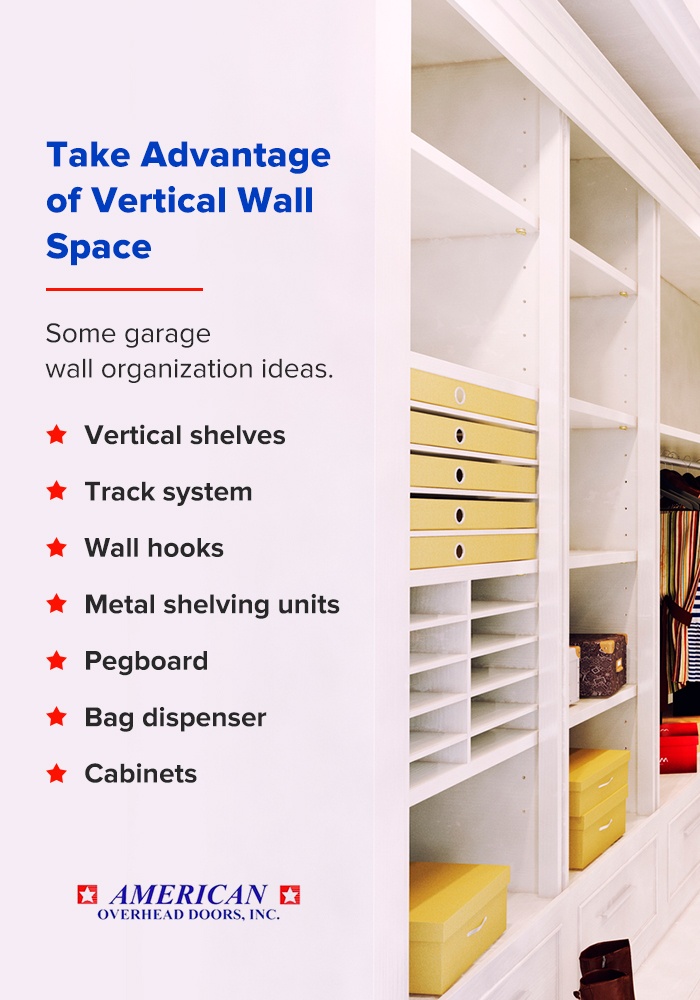
Instead of having all your items on the floor, use the wall space in your garage for extra storage. Here are some garage wall organization ideas.
- Vertical shelves: Install shelves to use as much vertical wall space as possible. You can put wall shelves at any height. Choose from plastic, wood or metal shelving, depending on much weight you need them to hold. Check the instructions from the manufacturer before installing them.
- Track system: A bar along your wall can hold hooks or shelves. You could store rakes, tools or buckets with these versatile systems. Use a track system for items with awkward shapes like landscaping equipment. Track systems can accommodate most of your garage door storage ideas to maximize all the wall space in your garage.
- Wall hooks: Use wall hooks to store bulky items, so they’re not on the floor. Hooks don’t take up a lot of room on your wall, so you have space for more storage. You could store a bicycle on a wall hook.
- Metal shelving units: If you have concrete walls, use metal shelving units in place of wall shelves. Push these shelves against the wall to leave space on your floor for your car and other items. Metal shelving units can withstand the extreme temperatures of uninsulated garages. They’re also sturdy enough to hold heavy weight.
- Pegboard: Install a pegboard on your wall to hang anything you like. This unit is a great place to organize your tools so you can see them all at once. Pegboards are handy for cleaning supplies and other lightweight items.
- Bag dispenser: Mount a bag dispenser on the wall to keep track of old shopping bags. Most bag dispensers stick right onto the wall without needing any extra equipment.
- Cabinets: Mount cabinets onto the wall to store items you don’t use every day. Make sure to lock products with harmful chemicals in these cabinets if you have small children.
3. Add Ceiling Storage
If you run out of floor and wall storage, install any of these garage storage solutions onto your ceiling.
- Ceiling ladder lift: Instead of leaning your ladder against the wall, create a lift mounted from the ceiling. Organize your garage in such a way that it’s easy to access when you need it.
- Overhead storage racks: If you’ve used all the storage space on your floors and walls, consider building up. Easy-to-install metal storage racks can hold hundreds of pounds. Make sure to allow enough space for your garage door and garage door opener. You could store seasonal items or luggage in these storage racks.
- Storage pulley system: A storage pulley system gives you access to bins in high places without the need for a ladder. You could use a pulley system to store items that you want out of sight, but that you need to access more often. Consider using this system for gardening equipment or seasonal decorations.
- Overhead loft: You could use the extra space from your high ceiling by creating an overhead loft. Make sure you have enough clearance for your car to store items you don’t need to use as much, like camping equipment.
Unique Garage Organization Tips and Tricks
Since you’re doing this yourself, you have more flexibility with what you use to store your items. Here are some exciting, one-of-a-kind ways to save the items in your garage.
- Store your bike with a hook or pulley system: You could install a hook on the ceiling or wall for flexible space for your bike. You could also use a pulley system to bring the bike to the ground for easy transport.
- Use magnetic storage: Metallic shelves, tracks or cabinets can be home to small items like tools to put them in a visible location.
- Merge like items: You should group similar things to save space. If you’ve bought several boxes of nails, buy one storage container for all of them.
- Create a drop-off zone: At the end of a long day, it’s easy to throw your stuff on the couch or living room floor. If your kids play sports or you often work in the yard, create a place to dump your stuff when you’re tired. Make sure to put the items away when you’re ready so that you could avoid making a mess in your garage again.
Adding Finishing Touches to Your Organized Garage
When you’ve organized your garage, consider what you could do to enhance its appearance even more. You may notice some paint chips on the wall or some scuff marks on the floors. Think about how you want to use your garage. Is it where you park your car or a place to work out in the morning?
Here are some finishing touches on how to clean up your garage.
- Deep clean: When deep-cleaning your garage, wear gloves in case you come across any bugs or harmful chemicals. Dust the garage from top to bottom, starting with the ceiling and ending with the floor. Wipe the walls and doors with warm water and mild detergent. Mop the floor or hose it off, allowing a couple of hours for it to dry.
- Flooring: Look at your garage and figure out how you want to use this new space. If you don’t have much extra room to spare in your house, the garage could be a great place to set up a gym or an office. To create a more inviting place, add an area rug to the garage. If you’re going to use it as a home for your car, you could leave the floors bare. Most garage floors only need an epoxy finish to restore their shine.
- Repair or replace the garage door: Your garage door has taken some hits over the years. If you’ve had issues with opening your garage door, consider getting it repaired. If you’ve had your garage for a while, you should upgrade to a new garage door and garage door opener.
Finish Your Garage With a New Garage Door From American Overhead Door in Connecticut
A sturdy garage door can protect your clean garage. As a Clopay Master Authorized Dealer, we specialize in providing high-quality garage doors in Connecticut. Browse through our collection of residential garage doors to upgrade your living space. You should also get a new LiftMaster garage door opener to go with your new door. For more information, give us a call at 860-347-1507 or contact us online.
Signs Your Garage Door Needs Repairs
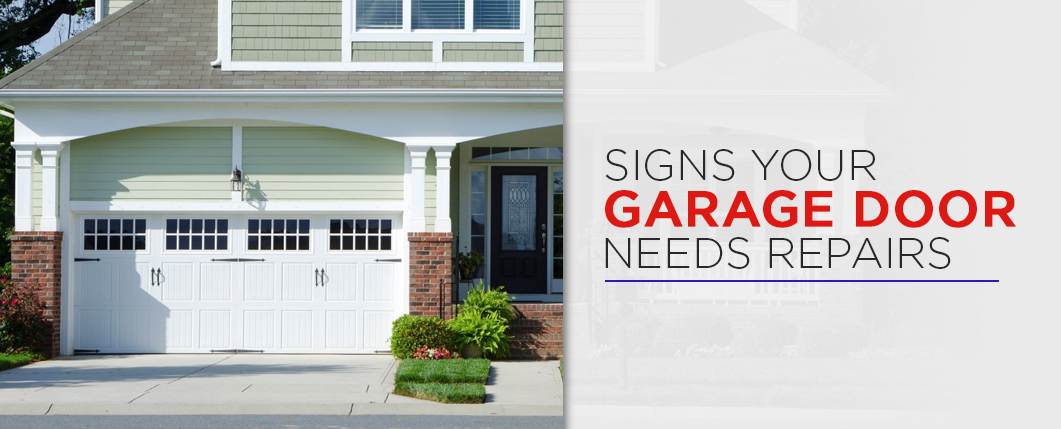
Garage doors are a vital component of every home — they protect our cars and homes while boosting curb appeal. However, despite using garage doors every day, we almost never dedicate any time to examining their condition — unless, of course, something goes wrong. In this article, we’ll discuss some symptoms that commonly indicate when you should have your door repaired. (more…)



